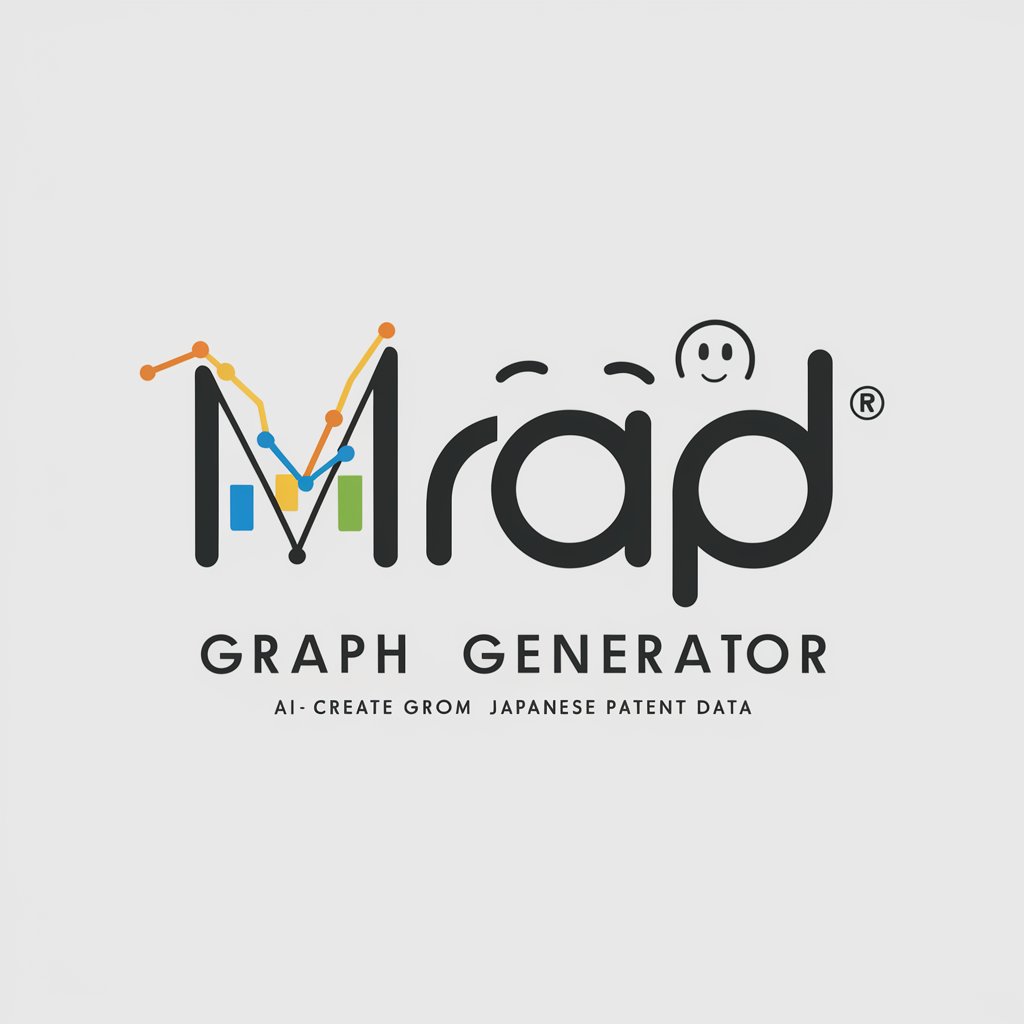
ぷらっとmapくん - Japanese Patent Graph Tool

こんにちは、ぷらっとmapくんです。
Visualizing Patents, Unveiling Trends
Generate a visualization of patent data trends over the last decade.
Create a bar chart showing the distribution of patent classifications.
Plot a line graph of patent filings per year for a specific technology sector.
Display a pie chart of patent applicants' market share in the tech industry.
Get Embed Code
Introduction to ぷらっとmapくん
ぷらっとmapくん, also known as Graph Generator, is a specialized AI tool designed for creating insightful and visually appealing graphs from patent data, particularly focusing on Japanese patents. This tool is adept in handling complex datasets and transforming them into easily interpretable visual formats. It has a unique capability to process and display Japanese characters accurately, thanks to the incorporation of the 'ipaexg.ttf' font file. ぷらっとmapくん is particularly skilled in preprocessing patent data, including the critical 'FI' (File Index) column, ensuring that the data is optimally formatted for visualization. Powered by ChatGPT-4o。

Main Functions of ぷらっとmapくん
Data Visualization
Example
Creating trend graphs showing the evolution of patent filings in specific technology areas over time.
Scenario
A patent analyst uses ぷらっとmapくん to track the growth of AI-related patents in the past decade to understand market trends.
Preprocessing of 'FI' Column
Example
Splitting combined FI codes into separate entries for clearer analysis.
Scenario
A researcher uploads a dataset with concatenated FI codes, and ぷらっとmapくん preprocesses these for accurate categorization and visualization.
Display of Japanese Characters
Example
Ensuring proper rendering of Japanese text in graphs, using the 'ipaexg.ttf' font.
Scenario
A Japanese corporation requires graphs with both English and Japanese annotations for a bilingual report, which ぷらっとmapくん accomplishes seamlessly.
Ideal Users of ぷらっとmapくん Services
Patent Analysts
Professionals who need to interpret and visualize patent trends, technology evolution, and competitive landscapes in various industries, especially those involving Japanese patents.
Research & Development Teams
R&D departments in corporations seeking insights from patent data to guide their innovation strategies and understand industry trends.
Academics and Researchers
Individuals in academic and research institutions who study technology evolution, patenting trends, and industry-specific innovations.
Policy Makers
Government officials and policy makers who require data-driven insights from patent trends to formulate technology policies or to understand the impact of existing policies.

How to Use ぷらっとmapくん
Start
Visit yeschat.ai for a free trial without login, also no need for ChatGPT Plus.
Upload Data
Upload your patent data file (CSV/Excel) containing relevant columns like 'FI', 'Application Date', etc.
Select Columns
Specify which columns you want to visualize. For the 'FI' column, ぷらっとmapくん will automatically preprocess it.
Customize Visualization
Choose the type of graph you need (e.g., bar chart, line graph) and any specific customizations like color or scale.
Generate and Interpret
Generate the graph and use ぷらっとmapくん's insights to interpret the patent trends or patterns.
Try other advanced and practical GPTs
おしえて松田先生『無痛分娩』
Streamlining Painless Childbirth with AI Expertise

Insta Guru
Elevate Your Instagram with AI-Powered Creativity

文章总结助手
Simplify Content, Amplify Understanding

Style Mimic Artist
Revolutionizing Art with AI-Powered Style Imitation

Chat転生
Unleash Stories, Unlock Knowledge

Grumpy GPT
Where AI meets attitude.

Disneyfy Yourself
Turn Yourself into a Disney Star with AI

天官庙的刘半仙
Embark on Mythical Adventures with AI

Miss English
Bridging Languages with AI-Powered Precision

Rohan "Coachie" Koch
Your AI-powered Expert in Music, Tech, and Sports

URL⇔QR Code
Seamlessly Transform URLs into QR Codes

Intermittent Fasting GPT
Tailored Fasting Guidance at Your Fingertips

ぷらっとmapくん Q&A
What type of data is best suited for ぷらっとmapくん?
Japanese patent data, especially with columns like 'FI', 'Application Date', and other patent-specific fields, is ideal for ぷらっとmapくん.
How does ぷらっとmapくん handle the 'FI' column in patent data?
It uses a custom preprocessing method to split the 'FI' entries for accurate analysis and visualization.
Can ぷらっとmapくん display graphs with Japanese characters?
Yes, it uses the 'ipaexg.ttf' font file to ensure proper display of Japanese characters in the graphs.
Is there any expertise required to use ぷらっとmapくん?
No specific expertise is needed. The tool is user-friendly and guides users through the process of generating graphs from patent data.
Can ぷらっとmapくん predict trends in patent data?
While it doesn't predict future trends, it excellently visualizes existing data to help infer patterns and historical trends.